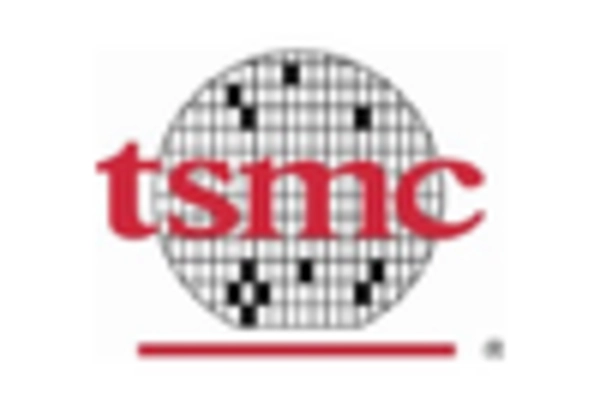Advancements in Semiconductor Technology
Advancements in semiconductor technology are a crucial driver for the 3D Through-Silicon-Via (TSV) Device Market. The continuous evolution of semiconductor fabrication techniques has enabled the development of smaller, more efficient chips that can leverage TSV technology. Innovations such as extreme ultraviolet lithography and advanced materials are enhancing the capabilities of TSV devices, allowing for greater integration and performance. The semiconductor market is projected to reach USD 600 billion by 2025, with TSV technology playing a vital role in this growth. As manufacturers strive to push the boundaries of chip performance, the adoption of TSV solutions is likely to accelerate, further solidifying their position in the semiconductor landscape.
Integration of 3D Packaging Technologies
The integration of 3D packaging technologies is a pivotal driver for the 3D Through-Silicon-Via (TSV) Device Market. As manufacturers seek to optimize space and improve performance, the adoption of 3D packaging solutions has gained momentum. TSV technology allows for vertical stacking of chips, which not only reduces the footprint but also enhances interconnectivity between components. This trend is particularly evident in sectors such as telecommunications and automotive, where space constraints are critical. Market analysis indicates that the 3D packaging segment is expected to witness substantial growth, with projections suggesting a market size exceeding USD 20 billion by 2026. This growth underscores the importance of TSV devices in meeting the demands of compact and efficient electronic systems.
Rising Demand for High-Performance Computing
The 3D Through-Silicon-Via (TSV) Device Market is experiencing a surge in demand driven by the increasing need for high-performance computing solutions. As applications in artificial intelligence, machine learning, and data analytics expand, the requirement for faster and more efficient data processing becomes paramount. TSV technology facilitates higher bandwidth and lower latency, making it an attractive option for data centers and cloud computing providers. According to industry estimates, the market for high-performance computing is projected to grow at a compound annual growth rate of over 10% in the coming years. This growth is likely to propel the adoption of TSV devices, as they offer enhanced performance capabilities that align with the evolving needs of computationally intensive applications.
Growing Focus on Miniaturization and Performance
The growing focus on miniaturization and performance optimization is driving the 3D Through-Silicon-Via (TSV) Device Market. As consumer electronics evolve, there is an increasing demand for smaller, more powerful devices. TSV technology facilitates the stacking of multiple chips, which not only conserves space but also enhances performance through improved thermal management and reduced signal loss. This trend is particularly relevant in mobile devices and high-end computing systems, where performance and size are critical factors. Market forecasts suggest that the miniaturization trend will continue to gain traction, with the TSV segment expected to capture a larger share of the semiconductor market as manufacturers prioritize efficiency and compact design.
Emerging Applications in IoT and Wearable Devices
The proliferation of Internet of Things (IoT) and wearable devices is significantly influencing the 3D Through-Silicon-Via (TSV) Device Market. As these technologies become more prevalent, the need for compact, energy-efficient solutions is paramount. TSV technology enables the integration of multiple functionalities into a single package, which is essential for the miniaturization of IoT devices. Furthermore, the market for wearable technology is anticipated to grow at a rate of approximately 15% annually, creating a substantial opportunity for TSV devices. This growth is likely to drive innovation in the design and manufacturing of TSV-enabled products, catering to the increasing consumer demand for smart, connected devices.
















Leave a Comment